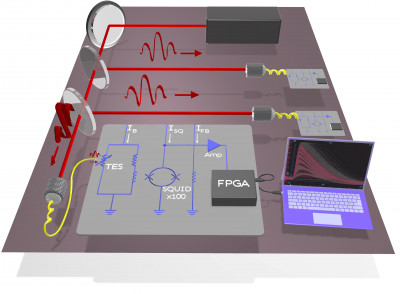NEWPORT NEWS, Va., April 28, 2023 — Researchers at the U.S. Department of Energy’s Thomas Jefferson National Accelerator Facility have demonstrated the application of a photon-number-resolving system to accurately resolve more than 100 photons. Individual detectors today can resolve up to about 10 photons, which is too small a number for many quantum-state generation methods. The record, according to the researchers, had been 16 photons.
Simulations suggest that quantum computing will require detecting large numbers of photons — 50 or more.
In addition, the system could be used for quantum key distribution (QKD), which is a sought-after technology for secure military communications and financial transactions. The quantum detection of photons is also vital to optical computing efforts.
According to Amr Hossameldin, a member of the research team and a graduate research assistant in quantum computing and quantum optics at the University of Virginia (UVa), crossing the 50-photon threshold means being able to implement a “cubic gate” — which itself is a milestone toward building a complete gate set for universal quantum computing.
The researchers ultimately demonstrated a photon count of about 35 per single detector, and they reached 100 photons with a three-detector system.
“They could predict that they were resolving 100 of these photons that were impacting upon the detectors with this extremely accurate resolution,” said Robert Edwards, senior staff scientist and deputy associate director for theoretical and computational physics at Jefferson Lab. “It’s super accurate — and that has never been achieved.
“The lack of detection has been a major limitation to this approach of quantum computing. The new photon number resolution is the necessary step to implementing a universal instruction set.”
The detection system also has another highly valuable secondary benefit: quantum generation of truly random numbers. This quality represents a boon to unbreakable secret codes or encryptions in such areas as military communications and financial transactions. So-called random numbers generated by classical computer algorithms aren’t truly random. The algorithm they are generated from can be compromised with some effort by playing a numbers game — looking for which numbers pop up more often than others. True random-number generation using quantum physics has no such flaw or bias.

Jefferson Lab engineers helped design and build a photon detection system that’s key to photonics-based quantum computing and unbreakable encryption techniques. Courtesy of Jefferson Lab.
“There is an intrinsic randomness in quantum mechanics, where you can have a physical system that’s in two states at once,” said Olivier Pfister, a physics professor at UVa who specializes in quantum fields and quantum information and served as external team leader for the project. “And when you want to know which it is, it’s random.”
The research was published in Nature Photonics (www.doi.org/10.1038/s41566-022-01105-9).